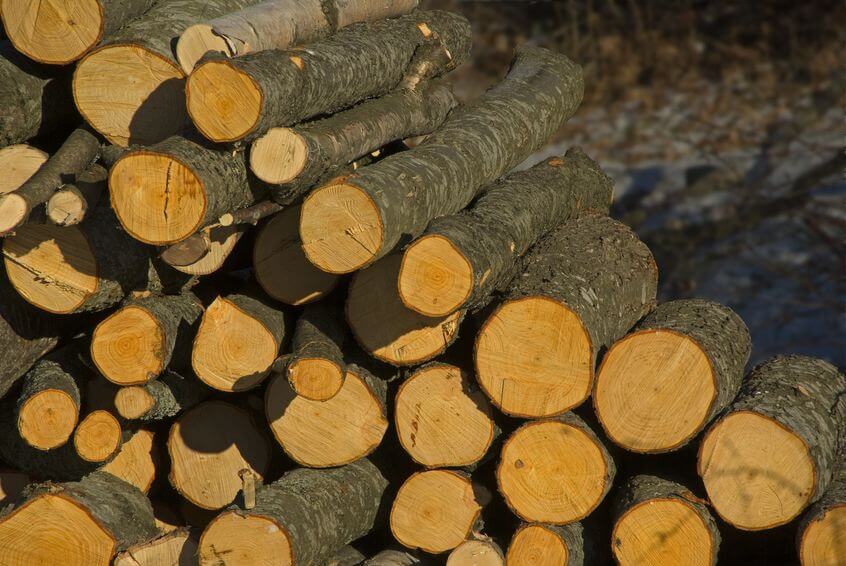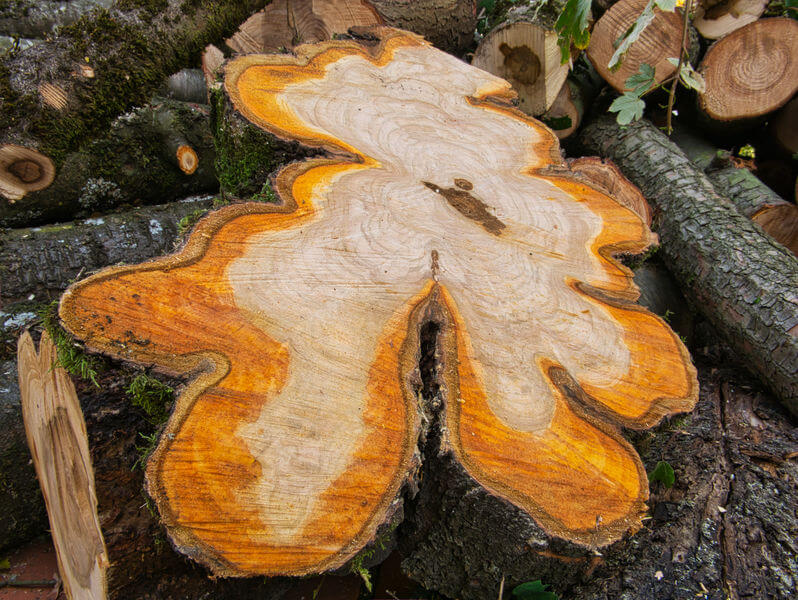Wondering if cherry wood is bad to burn in your fireplace or wood-burning stove? Well, you’ve come to the right place! In this article, we’ll explore the pros and cons of using cherry wood as a fuel source. So, sit back, relax, and let’s dive into the sizzling world of cherry wood!
When it comes to choosing the best firewood, there are various factors to consider. And one burning question (pun intended!) is whether cherry wood is a good option. Well, my friend, we’re here to shed some light on this topic and help you make an informed decision. So, join us on this fiery adventure as we uncover the truth about cherry wood as a fuel source.
Now, before you start worrying about burning cherry wood, let’s first take a closer look at its characteristics and potential benefits or drawbacks. So, grab your marshmallows, because we’re about to roast some myths and reveal the real deal about cherry wood as a burning material. Let’s get started!

Is Cherry Wood Bad to Burn?
Cherry wood is a popular choice for both furniture and firewood due to its beautiful grain pattern and rich color. However, when it comes to using cherry wood as firewood, there are a few factors to consider. In this article, we will explore whether cherry wood is bad to burn, examining its qualities, benefits, and potential drawbacks. By the end, you’ll have a better understanding of whether or not cherry wood is a suitable option for your fireplace or wood-burning stove.
The Qualities of Cherry Wood
Cherry wood is a hardwood that comes from the cherry tree (genus Prunus). It’s known for its fine grain and smooth texture, which make it a popular choice in furniture making. When used as firewood, cherry wood produces a pleasant aroma and crackles as it burns, adding to the ambiance of your space. The wood is dense and durable, which means it burns slowly and provides long-lasting heat. Additionally, cherry wood is easy to split, making it convenient for those who split their firewood themselves. Overall, cherry wood is prized for its aesthetics and functional qualities.
Despite its numerous positive attributes, there are some considerations to keep in mind when using cherry wood as firewood. One potential drawback is the cost. Cherry wood can be more expensive compared to other types of firewood, such as oak or birch. This is because cherry trees are relatively small and don’t yield as much usable wood. Additionally, cherry wood has a lower heat output compared to some other hardwoods. While it still provides ample warmth, you may need to burn more cherry wood to achieve the desired temperature. Finally, cherry wood can produce more ash when burned compared to other hardwoods, which means more frequent maintenance of your fireplace or stove may be required. Keep these factors in mind when deciding whether cherry wood is the right choice for you.
The Benefits of Burning Cherry Wood
Despite the potential drawbacks, there are several benefits to burning cherry wood. First and foremost, cherry wood produces a pleasant and fragrant smell when burned. The aroma adds a cozy and inviting atmosphere to your home, making it perfect for those chilly winter evenings. Additionally, cherry wood burns slowly and evenly, providing a consistent heat source. This makes it ideal for heating larger areas or maintaining a steady temperature throughout the night. Cherry wood also produces a beautiful flame with a vibrant red color, creating a visually appealing focal point in your fireplace or stove. Lastly, cherry wood is readily available in many regions, making it an accessible option for those looking for a renewable and sustainable source of heat.
In conclusion, while cherry wood may have a few drawbacks, its qualities and benefits make it a viable option for firewood. The beautiful aroma, steady burn, and aesthetic appeal make it a popular choice among homeowners. Just be mindful of the potential cost and increased ash production compared to other hardwoods. If you enjoy the ambiance and unique characteristics of cherry wood, it can be a great addition to your fireplace or wood-burning stove. Whether you’re looking to heat your home or simply enjoy a cozy evening by the fire, cherry wood can certainly enhance your experience.
Cherry Wood vs. Other Firewood Options
When considering whether cherry wood is a good option for burning, it’s helpful to compare it to other commonly used firewood types. In this section, we will explore how cherry wood stacks up against oak, birch, and pine.
Cherry Wood vs. Oak
Both cherry wood and oak are hardwoods that can be used as firewood. While oak is known for its high heat output and long burn time, cherry wood has a more pleasant aroma and distinctive crackling sound. Oak is also generally less expensive and produces less ash compared to cherry wood. However, if you value the aesthetics and fragrance of cherry wood, it can be a worthwhile alternative to oak.
Cherry Wood vs. Birch
Birch is another popular firewood choice due to its high heat output and easy ignition. Unlike cherry wood, birch burns quickly and may require more frequent replenishing in the fireplace or stove. Cherry wood, on the other hand, burns more slowly and provides a longer-lasting heat source. If you’re looking for a firewood option that requires less maintenance and doesn’t burn as quickly, cherry wood might be the better choice for you.
Cherry Wood vs. Pine
Pine wood is widely available and often used as firewood due to its affordability. However, it has a lower heat output compared to cherry wood and tends to produce more creosote, a flammable substance that can build up in chimneys and increase the risk of chimney fires. Additionally, pine does not provide the same pleasant aroma and crackling sound as cherry wood. While pine may be a more budget-friendly option, cherry wood offers a more enjoyable and efficient burning experience.
Ultimately, the choice between cherry wood and other firewood options will depend on your priorities and preferences. Consider factors such as heat output, burn time, cost, aroma, and maintenance when making your decision. It’s also worth noting that combining different types of firewood can provide a balance of qualities, such as using oak for high heat output and cherry wood for its fragrance. Experiment and find the perfect combination that suits your needs and enhances your fireside experience.
Key Takeaways – Is Cherry Wood Bad to Burn?
- Cherry wood is not bad to burn as long as it is properly dried and seasoned.
- It produces a pleasant aroma while burning, making it a popular choice for fireplaces.
- Cherry wood burns at a moderate heat level, providing a steady and long-lasting fire.
- It creates beautiful red embers and glowing coals, adding to the visual appeal of a fire.
- However, it’s important to avoid burning green or unseasoned cherry wood, as it can produce excessive smoke and create a buildup of creosote in the chimney.
Frequently Asked Questions
In this section, we’ll address some commonly asked questions about burning cherry wood.
Why do people use cherry wood for burning?
Cherry wood is often prized for its sweet, pleasant aroma when burned. It can add a nice fragrance to your home and create a cozy atmosphere. Additionally, cherry wood is known for producing a steady and even heat, making it ideal for wood-burning stoves and fireplaces.
However, it’s important to note that cherry wood should be seasoned properly before burning to ensure optimal performance. This involves allowing the wood to dry out for at least six months to a year to reduce moisture content and improve its combustion efficiency.
Is cherry wood toxic when burned?
No, cherry wood itself is not toxic when burned. In fact, cherry wood is a popular choice for smoking food as it imparts a delicious flavor. However, it’s essential to use cherry wood that hasn’t been treated with any chemicals or finishes, as these can release harmful fumes when burned.
Always make sure you are using clean, untreated cherry wood sourced from reputable suppliers. Avoid using wood that has been painted, stained, or treated with any type of sealant, as these can release toxic substances when burned.
Does burning cherry wood produce a lot of smoke?
Cherry wood can produce a moderate amount of smoke when burned, but it is generally considered to be cleaner burning compared to some other types of wood. When properly seasoned and used in a well-maintained wood-burning appliance, cherry wood should produce minimal smoke and emissions.
To minimize smoke production, it’s crucial to use well-seasoned cherry wood and ensure proper air circulation in your wood-burning appliance. Regular chimney maintenance and proper ventilation can also help optimize the combustion process and reduce smoke output.
Can burning cherry wood cause creosote buildup?
When burned improperly, cherry wood can contribute to the formation of creosote in chimneys and flues. Creosote is a sticky byproduct of incomplete combustion that can accumulate and pose a fire hazard if not regularly cleaned.
To reduce the risk of creosote buildup, make sure you are burning dry, well-seasoned cherry wood and maintaining proper airflow in your appliance. Regular chimney cleanings by a professional are also necessary to remove any creosote deposits and ensure safe operation.
Are there any other considerations when burning cherry wood?
One important consideration when burning cherry wood is its hardness. Cherry wood is a hardwood, which means it can be more challenging to ignite compared to softwoods like pine. It may require a longer burn time and additional kindling to get a fire started.
It’s also worth noting that burning cherry wood can generate more heat compared to softer woods. This can be an advantage during colder months but may require adjustments in the amount of wood used during warmer seasons or in smaller spaces.

Summary
So, is cherry wood bad to burn? Well, it depends on how you use it. When cherry wood is properly seasoned and burned in a well-ventilated fireplace or stove, it can be a good source of heat. However, if it’s not dried well or burned in an open fire, it can create more smoke and soot, which is not ideal. So, make sure you have dry cherry wood and a good stove or fireplace before using it for burning.
In conclusion, cherry wood can be a suitable option for burning if it’s seasoned and used in the right way. Just remember to check the moisture content, use a well-ventilated fireplace or stove, and enjoy the cozy warmth it provides. Stay safe and have fun with your fire!
